Jumbo vs Jumbo
Δημοσιεύτηκε: Τρί Μάιος 31, 2011 5:12 pm
Patek Philippe Nautilus 5711/1A and the Audemars Piguet Royal Oak 15202S
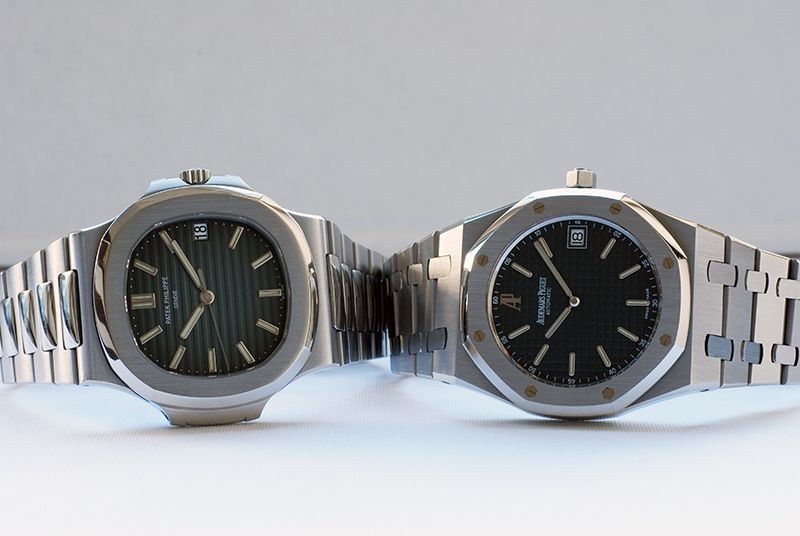
Introduction
You either like them or you don't, Gérald Genta's master pieces from the 1970s. Genta designed Omega watches for years (i.e. Constellation and Seamaster models) before he started his own company in 1969. Although designing watches was mostly a job that people did who were on the payroll of a watch manufacturer, it was an immediate success.
As we all know, Gérald Genta is the genius behind the Royal Oak watch (1972) from Audemars Piguet and the Nautilus watch (1976) from Patek Philippe. Both brands have a long history in watch making and both companies are considered 'high end' watch brands. Genta also designed the Ingenieur SL 1832 watch for IWC in the late 1970s, but the design of that particular watch has changed over the years. There is no current Ingenieur model that looks very similar to the original Ingenieur SL watch and therefore out of scope for this article.
Before the Royal Oak and Nautilus, Audemars Piguet and Patek Philippe did not manufacture sports watches. Their catalog included slim gold dress watches, with or without complications. I don't know if that period in time (1970s) forced Audemars Piguet and Patek Philippe to change that strategy or whether their customers just asked them for a stainless steel sports watch built with the craftsmanship and quality they were used to.
The Royal Oak and Nautilus have evolved over the last decades, like the Royal Oak Off-Shore series, Royal Oaks with all kind of mechanical complications and the Nautilus chronograph or Nautilus moon phase. The pure versions of the Royal Oak and Nautilus were always there though - in stainless steel - just like the initial models of the 1970s. Patek Philippe also introduced the Aquanaut, a more up-to-date version of the Nautilus, but purists seemed to have ignored that model.
This article covers the most pure Royal Oak and Nautilus, the ref.15202ST and the ref.5711/1A, the Jumbo and the Jumbo. Both in stainless steel with a stainless steel bracelet, just as Gérald Genta wanted them to be. Before these titans meet each other, let's briefly introduce them one by one.
Audemars Piguet Royal Oak 15202ST
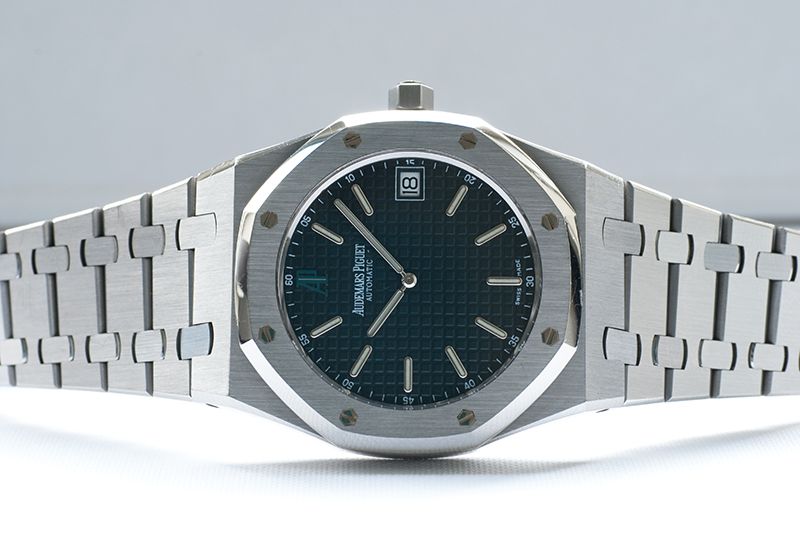
About 40 years ago, 3000 Swiss Francs would buy you a very decent gold dress watch. Therefor, journalists and those involved in the watch industry were in shock to see Audemars Piguet introducing a stainless steel sports watch for that amount of money during the Basel watch exhibition of 1972.
This stainless steel Royal Oak ref.5402ST nodded to the portholes of the HMS Royal Oak vessels (three in total) that had an octagonal shape. Of course, these British ships were named after the sacred tree that hid King Charles II of England and protected him from his pursuers - the so-called roundheads - in 1651.
Besides the odd octagonal shape and the use of stainless steel, the watch was considered to be very flat. Especially for an automatic wrist watch. Inside, Audemars Piguet used their caliber AP2121, derrived from the caliber 920 of Jaeger-LeCoultre. This is the movement that Audemars Piguet still uses today for their Royal Oak 'Jumbo' and they are the only ones who actually are allowed to use it (it has been licensed).
Through-out the years, Audemars Piguet used four references for this 'original' Royal Oak, namely ref.5402ST, ref.14802ST, ref.15002ST and the current ref.15202ST. I use the term 'original', as Audemars Piguet introduced a large number of variations on the Royal Oak during the 1980s, 1990s and still does. In 1993, Audemars Piguet developed and introduced a more sporty update under the sub name 'Offshore'. However, I believe that's a different story.
Nowadays often confused with the Royal Oak Date ref.15300ST (which is a bit thicker and has the second hand), the 'Jumbo' ref.15202ST is the Royal Oak discussed here. This 39mm diameter watch has a 8mm thick case and measures 49mm from lug to lug. Although measured a bit differently from the Patek Philippe Nautilus, one could say the Royal Oak is a tad bit smaller according to its specifications.
Patek Philippe Nautilus 5711/1A
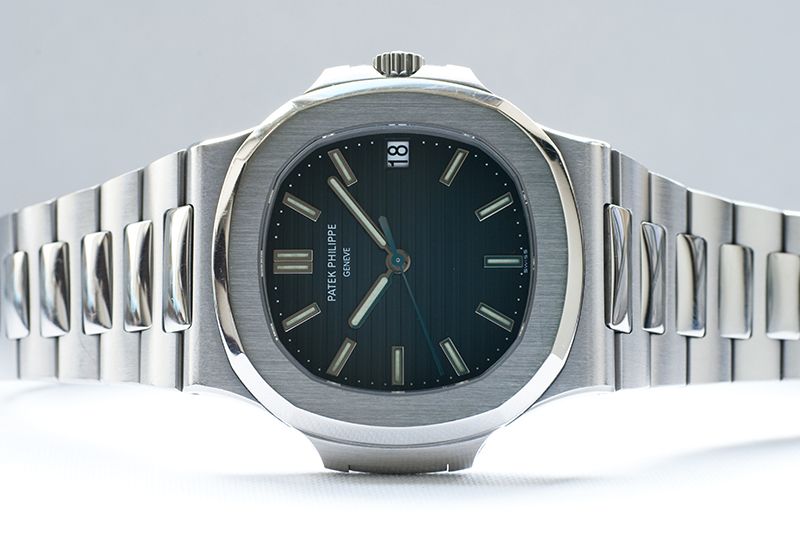
Patek Philippe introduced the Nautilus in 1976, only 4 years after Audemars Piguet's succesful introduction of the Royal Oak during the watchfair in Basel, Switzerland. The correct reference of the first Nautilus is ref. 3700/1. This 42.8mm x 41.8mm watch was huge for that time (hence the 'Jumbo'), where even a diameter of 36mm was above standard for Patek Philippe. In the early years, the Nautilus used caliber 28-255 C, based on Jaeger-LeCoultre's caliber 920. This same movement was used in the first Royal Oak and Vacheron Constantin '222', designed by Hysek.
The Nautilus was somewhat the enfant terrible of Patek Philippe, as it was so different from their other time pieces. It seemed that since the introduction, this watch had (and still has) its own following. Patek Philippe made a few deviations of the original model, smaller in size, and the 'Jumbo' was even discontinued in 1990. Meanwhile, the Nautilus - and especially the 'Jumbo' models - had turned into a cult object and even the 42mm 1998 Nautilus ref. 3710/1 with power reserve couldn't still the followers' hunger for the original Jumbo.
In 2006, 30 years after the initial introduction of the Nautilus 'Jumbo', Patek Philippe introduced the 5711/1A. A worthy successor of the original 'Jumbo' with its 43mm and hour, minute and seconds hand only dial. The movement inside is Patek's caliber 324 SC, their own manufacture movement.
In Comparison
To make it easier on our selves, we just use Royal Oak when discussing the ref.15202ST 'Jumbo' and Nautilus when discussing the ref.5711/1A 'Jumbo' during the rest of this article.
Often mentioned in one sentence, the original Nautilus and the Royal Oak are very different watches when you wear them. Watchuseek had the opportunity to have them both for a while and share our findings with you. Both have a serious price tag, people today are giving the same reaction when they hear the current list price as they did in the 1970s. The Nautilus has a list price of 18.300 Euro and the Royal Oak has a list price of 16.300 Euro. As the most common thing for non-watch aficionados is to ask about price of the watch you are wearing when they hear you are a fan of high-end watches, almost all of them could not believe their ears. So the original '1972 effect' of the high price of a stainless steel watch is still there.
Having that said, you might be used to discounts on list prices of watches. Even though you can expect to receive an interesting discount on the Royal Oak, the Nautilus is very close to retail and sometimes even over list, as we were used from the Rolex Daytona in the late 1990s and 2000s. A waiting list at the authorized dealer goes for both models, as they have both low production numbers. However, we personally have seen the Nautilus in stock at a large watch dealer in New York City last year and just recently noticed two Royal Oak watches in stock at an authorized dealer in Capri, Italy.
In short, the Royal Oak comes with more discount than the Nautilus and the difference in price between these watches can easily run up to 7.000 to 8.000 Euro for a BNIB (brand new in box) piece.

When wearing the watches or looking at the watch side by side, as pictured above, you will quickly draw the conclusion that although both are designed by the same fellow, these watches are quite different from each other. Although the specifications told you other wise, the Royal Oak feels and shows a bit bigger than the Nautilus. The Nautilus is a bit wider though, due to its 'ears' on each side.
The lunette on both watches is just stunning. Although the Nautilus has a more overall polished look, the satinized parts are finished with the out most precision and care. The looks of the Royal Oak are a bit more 'hard core' with its white gold 8 octagonal bolts, but nevertheless as superb finished as the Patek Philippe. Just different. It is up to one's taste which look is to be preferred.
Because the lugs of the Royal Oak are a bit longer and welded along down the wrist, this watch wears a bit bigger and is not suitable for people with a very small wrist as it will stick out a bit. The Nautilus, although measured a bit bigger, has shorter lugs on each sides making it a fit for every type of wrist.
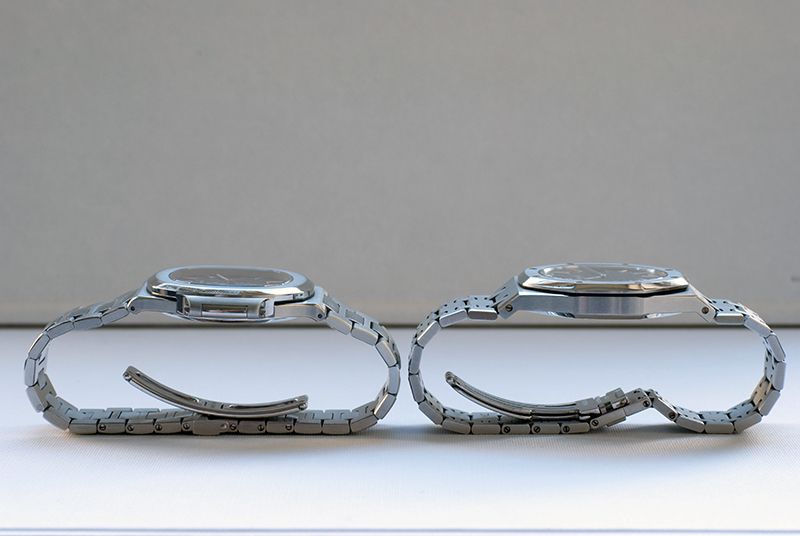
With respect to the height of the watch, there isn't much difference. The Royal Oak measures 8 mm in height and the Nautilus measures 8.6mm in height.
Movements
Also in terms of specifications, there isn't much to argue about. The Royal Oak's caliber 2121 movement is only 3.05mm in height and the Nautilus's caliber 324SC movement is 3.3mm in height. Only a very small difference, although the technique behind this non-complicated movement does differ. The caliber 2121 uses a rail to host the 21 carat gold skeletonized rotor of the movement instead of the more usual ball bearing system that Patek's caliber 324 SC uses.
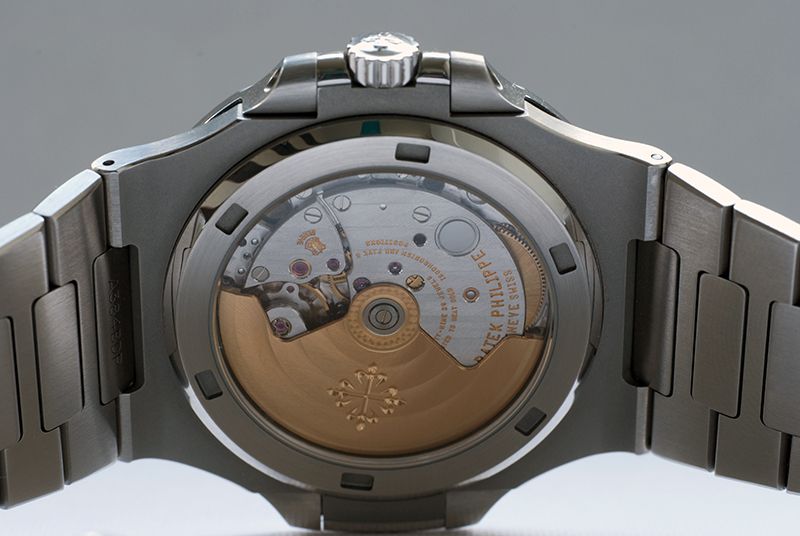
Patek Philippe caliber 324 SC seen through its transparent case back.
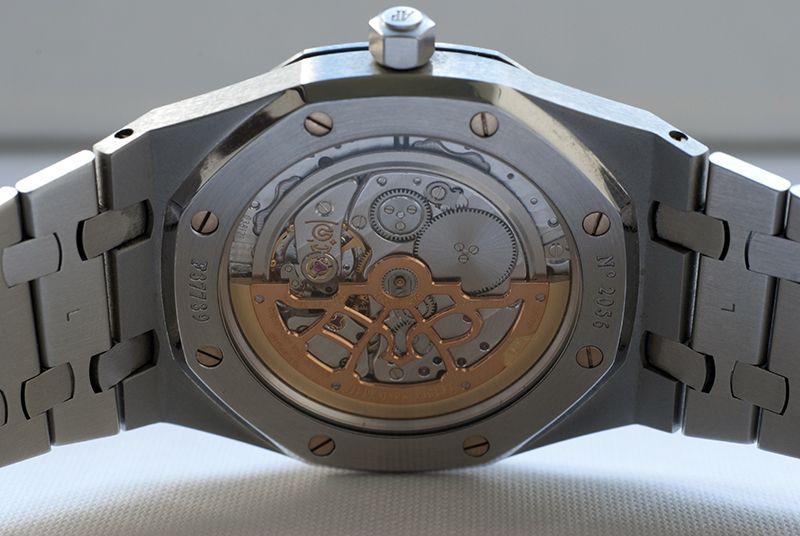
Audemars Piguet caliber 2121 with its skeletonized rotor.
Both movements have been finished with the same dedication and signs of craftsmanship, both movements use the Gyromax balance system and both movements are well respected amongst watch makers and collectors. Due to the skeletonized rotor and the rail system of the rotor we are bound to say that if we had to make a decision at all, we'd prefer AP's movement. However, there is no real preference so we'd say it is a break even here.
We do would like to note that this movement is where the Royal Oak 'Jumbo' stands out from his younger brother, the ref.15300ST with its in-house AP caliber 3120. The construction of the 2121 caliber is more expensive to produce and enables the 'Jumbo' to have a flatter case (no second hand as well).
Dials
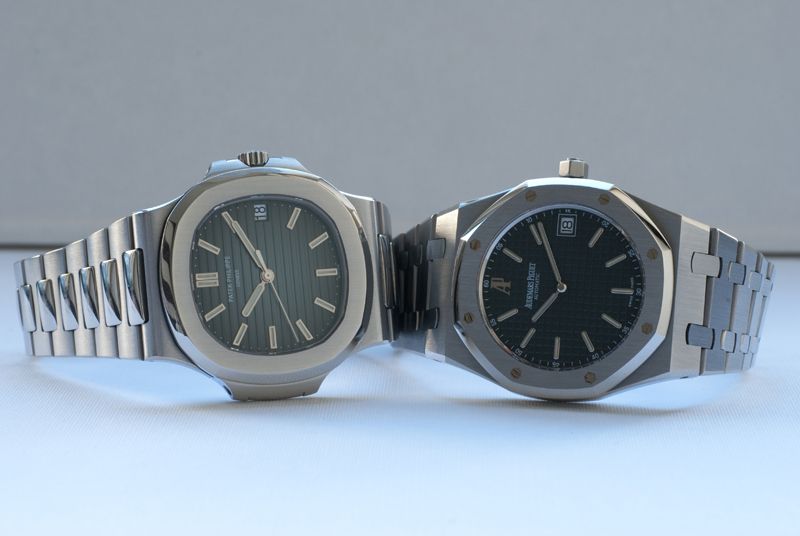
Available in just one color, the dial of the Nautilus is a real piece of art. The colors are mesmerizing when the angle of the light changes on the dial with its horizontal embossed bars. It might change from dark blue to green and it looks if the center part of the dial is more bright than the rest of it.
The dial of the Royal Oak is available in three flavors. The one we have is the charcoal dial, which is the darkest variant of the three. Then there is the white dial and the blue dial. The charcoal dial is being mistaken for either a black or dark blue dial some times, where the actual blue dial is deep blue. Although it is hard to capture the color of the charcoal dial, it is not as dynamic as the Nautilus dial.
The Royal Oak has the engine-turned 'clous de Paris' pattern on the dial, also called a tapisserie dial. Former references of the Royal Oak has a smaller pattern, which is considered to be nicer than the current one by many. However, this is the only remark we can give about this dial.
We've also taken a good look at the Nautilus dial and there is only one comment we have there as well. The date window is located a bit too far to the right, which makes the dial slightly out of balance. However, we are talking high-end watches here with a design that has proven itself over 30 years now. So these comments are very marginally.
Although the hands on the Nautilus are bit wider than those on the Royal Oak, they are in the same style. The Nautilus is - of course - featuring a second hand as well.
Bracelet and clasp
As previously stated, the looks of these watches are relatively different from each other. The Nautilus has a more smooth and refined look where as the Royal Oak is a bit more tough looking. The same goes for the bracelet of these iconic timepieces. Bracelets of this quality and finish are rare on sports watches and perhaps a bit thinner than most other bracelets.
The industrial look on the Royal Oak is liked by many and the comfort of it is much appreciated as well. Patek Philippe has created a bracelet that looks more 'soft' and rounded. Quality wise, we don't want to argue here. Both are scratch magnets, due to the satin finish and polished elements on the bracelet links. Some people tend to think that a different kind of stainless steel is being used (in comparison to other brand's sports watches) because they scratch so easily, but this is only due to the finish.
A double folding clasp has been used for the Nautilus and a single clasp for the Royal Oak. To each his own, but we do have a small favor for the AP signature in the clasp of the Royal Oak. A very nice detail. See for yourself.
One comment we have to make is that these bracelets feel so thin, it is almost like wearing a vintage and fragile watch. Not per se a bad thing, but be aware of this.
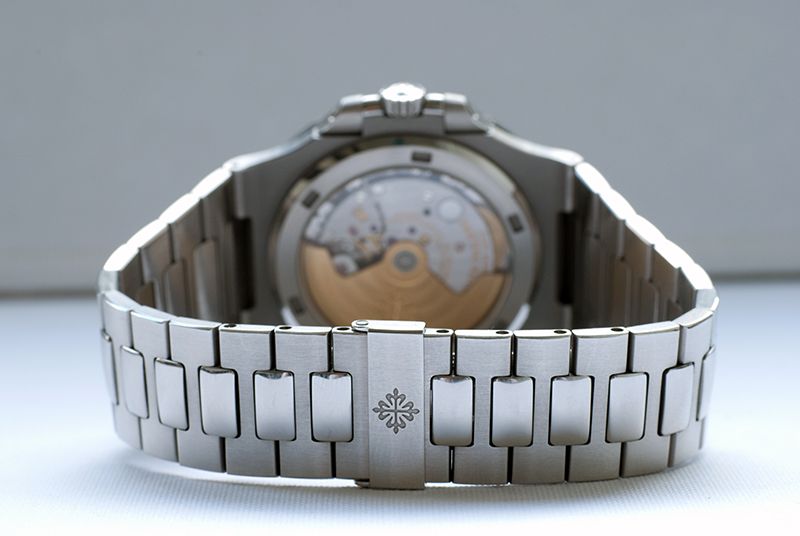
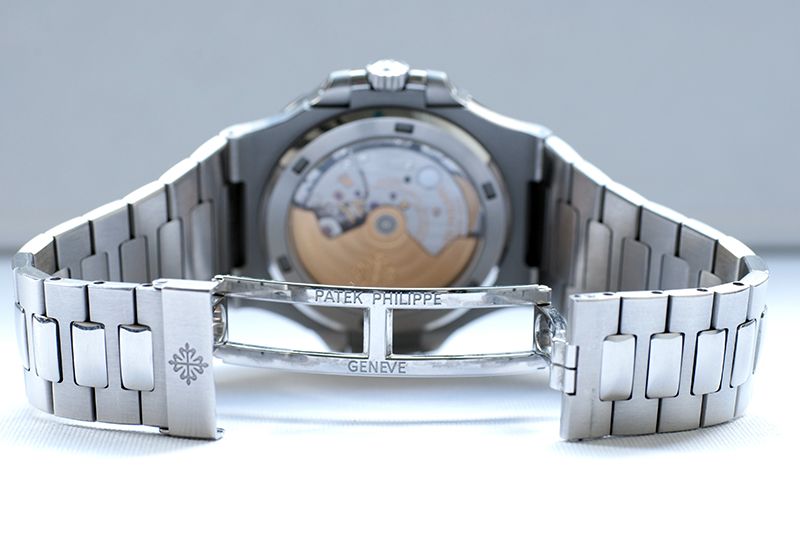
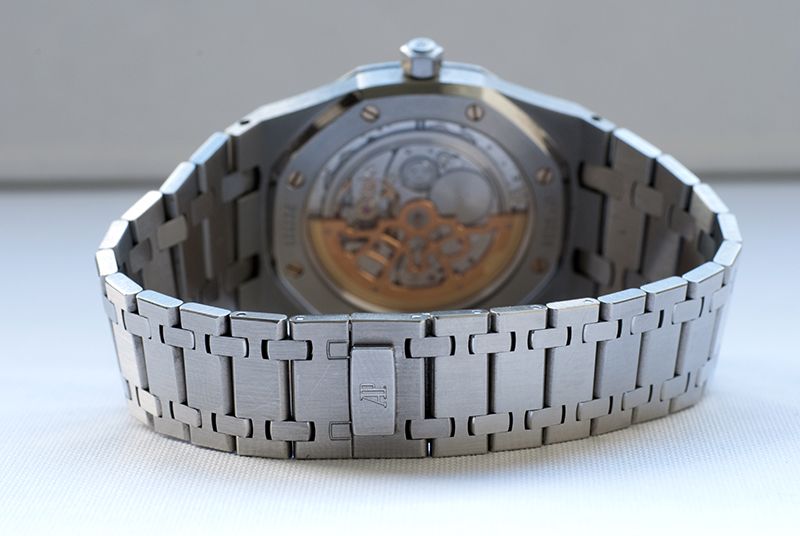
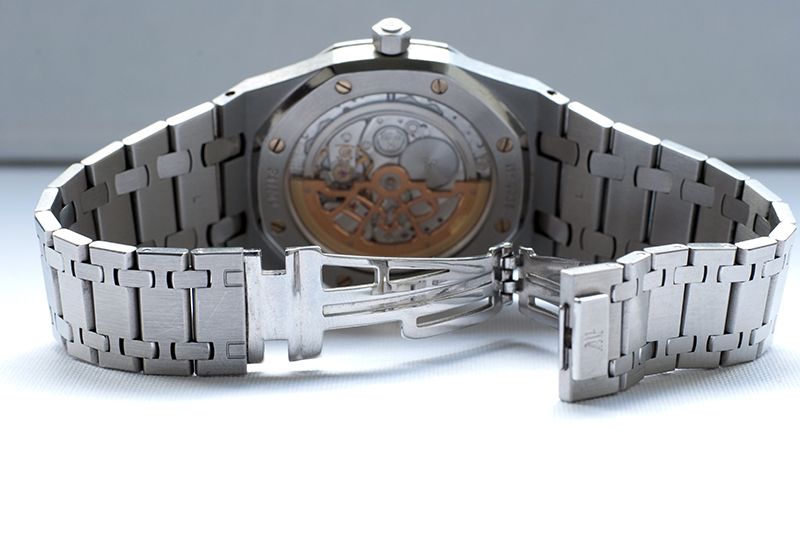
The verdict
So, what's the verdict after a period of wearing and comparing them? It remains a matter of taste really, but when you are able to see these watches as each other's direct opponents, the price difference of 7 to 8K Euro for a new piece including discount is quite steep. The Nautilus is surely the more sought-after watch of the two, hence the waiting list and asking prices that are over list price. The Royal Oak will give you at least as much bang for the buck as the Nautilus does, but one can't rule out emotion of course.
Personally, we think the Nautilus was a bit too small for our wrists whereas the Royal Oak felt perfect. The best thing you can do is try each of them by yourself, if you can find a dealer who has them on stock of course. However, there is probably always a watch aficionado nearby who has at least of them so you should be able to try one at a watch GTG or fair.
The question really is, which one do you favor? Or are both of these watches not of your interest? Like we wrote in the first sentence of this article, you either like them or you don't.

http://forums.watchuseek.com/f2/jumbo-v ... 46212.html

Introduction
You either like them or you don't, Gérald Genta's master pieces from the 1970s. Genta designed Omega watches for years (i.e. Constellation and Seamaster models) before he started his own company in 1969. Although designing watches was mostly a job that people did who were on the payroll of a watch manufacturer, it was an immediate success.
As we all know, Gérald Genta is the genius behind the Royal Oak watch (1972) from Audemars Piguet and the Nautilus watch (1976) from Patek Philippe. Both brands have a long history in watch making and both companies are considered 'high end' watch brands. Genta also designed the Ingenieur SL 1832 watch for IWC in the late 1970s, but the design of that particular watch has changed over the years. There is no current Ingenieur model that looks very similar to the original Ingenieur SL watch and therefore out of scope for this article.
Before the Royal Oak and Nautilus, Audemars Piguet and Patek Philippe did not manufacture sports watches. Their catalog included slim gold dress watches, with or without complications. I don't know if that period in time (1970s) forced Audemars Piguet and Patek Philippe to change that strategy or whether their customers just asked them for a stainless steel sports watch built with the craftsmanship and quality they were used to.
The Royal Oak and Nautilus have evolved over the last decades, like the Royal Oak Off-Shore series, Royal Oaks with all kind of mechanical complications and the Nautilus chronograph or Nautilus moon phase. The pure versions of the Royal Oak and Nautilus were always there though - in stainless steel - just like the initial models of the 1970s. Patek Philippe also introduced the Aquanaut, a more up-to-date version of the Nautilus, but purists seemed to have ignored that model.
This article covers the most pure Royal Oak and Nautilus, the ref.15202ST and the ref.5711/1A, the Jumbo and the Jumbo. Both in stainless steel with a stainless steel bracelet, just as Gérald Genta wanted them to be. Before these titans meet each other, let's briefly introduce them one by one.
Audemars Piguet Royal Oak 15202ST

About 40 years ago, 3000 Swiss Francs would buy you a very decent gold dress watch. Therefor, journalists and those involved in the watch industry were in shock to see Audemars Piguet introducing a stainless steel sports watch for that amount of money during the Basel watch exhibition of 1972.
This stainless steel Royal Oak ref.5402ST nodded to the portholes of the HMS Royal Oak vessels (three in total) that had an octagonal shape. Of course, these British ships were named after the sacred tree that hid King Charles II of England and protected him from his pursuers - the so-called roundheads - in 1651.
Besides the odd octagonal shape and the use of stainless steel, the watch was considered to be very flat. Especially for an automatic wrist watch. Inside, Audemars Piguet used their caliber AP2121, derrived from the caliber 920 of Jaeger-LeCoultre. This is the movement that Audemars Piguet still uses today for their Royal Oak 'Jumbo' and they are the only ones who actually are allowed to use it (it has been licensed).
Through-out the years, Audemars Piguet used four references for this 'original' Royal Oak, namely ref.5402ST, ref.14802ST, ref.15002ST and the current ref.15202ST. I use the term 'original', as Audemars Piguet introduced a large number of variations on the Royal Oak during the 1980s, 1990s and still does. In 1993, Audemars Piguet developed and introduced a more sporty update under the sub name 'Offshore'. However, I believe that's a different story.
Nowadays often confused with the Royal Oak Date ref.15300ST (which is a bit thicker and has the second hand), the 'Jumbo' ref.15202ST is the Royal Oak discussed here. This 39mm diameter watch has a 8mm thick case and measures 49mm from lug to lug. Although measured a bit differently from the Patek Philippe Nautilus, one could say the Royal Oak is a tad bit smaller according to its specifications.
Patek Philippe Nautilus 5711/1A

Patek Philippe introduced the Nautilus in 1976, only 4 years after Audemars Piguet's succesful introduction of the Royal Oak during the watchfair in Basel, Switzerland. The correct reference of the first Nautilus is ref. 3700/1. This 42.8mm x 41.8mm watch was huge for that time (hence the 'Jumbo'), where even a diameter of 36mm was above standard for Patek Philippe. In the early years, the Nautilus used caliber 28-255 C, based on Jaeger-LeCoultre's caliber 920. This same movement was used in the first Royal Oak and Vacheron Constantin '222', designed by Hysek.
The Nautilus was somewhat the enfant terrible of Patek Philippe, as it was so different from their other time pieces. It seemed that since the introduction, this watch had (and still has) its own following. Patek Philippe made a few deviations of the original model, smaller in size, and the 'Jumbo' was even discontinued in 1990. Meanwhile, the Nautilus - and especially the 'Jumbo' models - had turned into a cult object and even the 42mm 1998 Nautilus ref. 3710/1 with power reserve couldn't still the followers' hunger for the original Jumbo.
In 2006, 30 years after the initial introduction of the Nautilus 'Jumbo', Patek Philippe introduced the 5711/1A. A worthy successor of the original 'Jumbo' with its 43mm and hour, minute and seconds hand only dial. The movement inside is Patek's caliber 324 SC, their own manufacture movement.
In Comparison
To make it easier on our selves, we just use Royal Oak when discussing the ref.15202ST 'Jumbo' and Nautilus when discussing the ref.5711/1A 'Jumbo' during the rest of this article.
Often mentioned in one sentence, the original Nautilus and the Royal Oak are very different watches when you wear them. Watchuseek had the opportunity to have them both for a while and share our findings with you. Both have a serious price tag, people today are giving the same reaction when they hear the current list price as they did in the 1970s. The Nautilus has a list price of 18.300 Euro and the Royal Oak has a list price of 16.300 Euro. As the most common thing for non-watch aficionados is to ask about price of the watch you are wearing when they hear you are a fan of high-end watches, almost all of them could not believe their ears. So the original '1972 effect' of the high price of a stainless steel watch is still there.
Having that said, you might be used to discounts on list prices of watches. Even though you can expect to receive an interesting discount on the Royal Oak, the Nautilus is very close to retail and sometimes even over list, as we were used from the Rolex Daytona in the late 1990s and 2000s. A waiting list at the authorized dealer goes for both models, as they have both low production numbers. However, we personally have seen the Nautilus in stock at a large watch dealer in New York City last year and just recently noticed two Royal Oak watches in stock at an authorized dealer in Capri, Italy.
In short, the Royal Oak comes with more discount than the Nautilus and the difference in price between these watches can easily run up to 7.000 to 8.000 Euro for a BNIB (brand new in box) piece.

When wearing the watches or looking at the watch side by side, as pictured above, you will quickly draw the conclusion that although both are designed by the same fellow, these watches are quite different from each other. Although the specifications told you other wise, the Royal Oak feels and shows a bit bigger than the Nautilus. The Nautilus is a bit wider though, due to its 'ears' on each side.
The lunette on both watches is just stunning. Although the Nautilus has a more overall polished look, the satinized parts are finished with the out most precision and care. The looks of the Royal Oak are a bit more 'hard core' with its white gold 8 octagonal bolts, but nevertheless as superb finished as the Patek Philippe. Just different. It is up to one's taste which look is to be preferred.
Because the lugs of the Royal Oak are a bit longer and welded along down the wrist, this watch wears a bit bigger and is not suitable for people with a very small wrist as it will stick out a bit. The Nautilus, although measured a bit bigger, has shorter lugs on each sides making it a fit for every type of wrist.

With respect to the height of the watch, there isn't much difference. The Royal Oak measures 8 mm in height and the Nautilus measures 8.6mm in height.
Movements
Also in terms of specifications, there isn't much to argue about. The Royal Oak's caliber 2121 movement is only 3.05mm in height and the Nautilus's caliber 324SC movement is 3.3mm in height. Only a very small difference, although the technique behind this non-complicated movement does differ. The caliber 2121 uses a rail to host the 21 carat gold skeletonized rotor of the movement instead of the more usual ball bearing system that Patek's caliber 324 SC uses.

Patek Philippe caliber 324 SC seen through its transparent case back.

Audemars Piguet caliber 2121 with its skeletonized rotor.
Both movements have been finished with the same dedication and signs of craftsmanship, both movements use the Gyromax balance system and both movements are well respected amongst watch makers and collectors. Due to the skeletonized rotor and the rail system of the rotor we are bound to say that if we had to make a decision at all, we'd prefer AP's movement. However, there is no real preference so we'd say it is a break even here.
We do would like to note that this movement is where the Royal Oak 'Jumbo' stands out from his younger brother, the ref.15300ST with its in-house AP caliber 3120. The construction of the 2121 caliber is more expensive to produce and enables the 'Jumbo' to have a flatter case (no second hand as well).
Dials

Available in just one color, the dial of the Nautilus is a real piece of art. The colors are mesmerizing when the angle of the light changes on the dial with its horizontal embossed bars. It might change from dark blue to green and it looks if the center part of the dial is more bright than the rest of it.
The dial of the Royal Oak is available in three flavors. The one we have is the charcoal dial, which is the darkest variant of the three. Then there is the white dial and the blue dial. The charcoal dial is being mistaken for either a black or dark blue dial some times, where the actual blue dial is deep blue. Although it is hard to capture the color of the charcoal dial, it is not as dynamic as the Nautilus dial.
The Royal Oak has the engine-turned 'clous de Paris' pattern on the dial, also called a tapisserie dial. Former references of the Royal Oak has a smaller pattern, which is considered to be nicer than the current one by many. However, this is the only remark we can give about this dial.
We've also taken a good look at the Nautilus dial and there is only one comment we have there as well. The date window is located a bit too far to the right, which makes the dial slightly out of balance. However, we are talking high-end watches here with a design that has proven itself over 30 years now. So these comments are very marginally.
Although the hands on the Nautilus are bit wider than those on the Royal Oak, they are in the same style. The Nautilus is - of course - featuring a second hand as well.
Bracelet and clasp
As previously stated, the looks of these watches are relatively different from each other. The Nautilus has a more smooth and refined look where as the Royal Oak is a bit more tough looking. The same goes for the bracelet of these iconic timepieces. Bracelets of this quality and finish are rare on sports watches and perhaps a bit thinner than most other bracelets.
The industrial look on the Royal Oak is liked by many and the comfort of it is much appreciated as well. Patek Philippe has created a bracelet that looks more 'soft' and rounded. Quality wise, we don't want to argue here. Both are scratch magnets, due to the satin finish and polished elements on the bracelet links. Some people tend to think that a different kind of stainless steel is being used (in comparison to other brand's sports watches) because they scratch so easily, but this is only due to the finish.
A double folding clasp has been used for the Nautilus and a single clasp for the Royal Oak. To each his own, but we do have a small favor for the AP signature in the clasp of the Royal Oak. A very nice detail. See for yourself.
One comment we have to make is that these bracelets feel so thin, it is almost like wearing a vintage and fragile watch. Not per se a bad thing, but be aware of this.




The verdict
So, what's the verdict after a period of wearing and comparing them? It remains a matter of taste really, but when you are able to see these watches as each other's direct opponents, the price difference of 7 to 8K Euro for a new piece including discount is quite steep. The Nautilus is surely the more sought-after watch of the two, hence the waiting list and asking prices that are over list price. The Royal Oak will give you at least as much bang for the buck as the Nautilus does, but one can't rule out emotion of course.
Personally, we think the Nautilus was a bit too small for our wrists whereas the Royal Oak felt perfect. The best thing you can do is try each of them by yourself, if you can find a dealer who has them on stock of course. However, there is probably always a watch aficionado nearby who has at least of them so you should be able to try one at a watch GTG or fair.
The question really is, which one do you favor? Or are both of these watches not of your interest? Like we wrote in the first sentence of this article, you either like them or you don't.

http://forums.watchuseek.com/f2/jumbo-v ... 46212.html